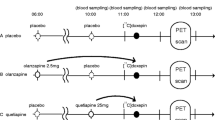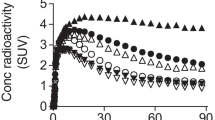Abstract
Rationale
First- and second-generation antihistamines are known to produce different degrees of sedation. However, a few studies have shown that the H1-antagonist fexofenadine produces mild stimulating effects. One hypothesis suggests that this is due to fexofenadine producing an increase in dopamine levels by blocking the dopamine transporter.
Objective
In this study, it was investigated whether a high dose of fexofenadine blocks the dopamine transporter in the striatum. In addition, the effect of fexofenadine on cognitive performance and motor impulsivity was investigated.
Methods
Sixteen healthy subjects were given either placebo or fexofenadine 360 mg. The binding potential of N-w-fluoropropyl-2β-carbomethoxy-3β-[4-iodophenyl] nortropane ([123I]FP-CIT) was measured using single-photon emission computed tomography (SPECT). Cognitive performance was measured in 40 subjects (20 placebo, 20 fexofenadine) using a digit symbol substitution test (DSST) and a stop signal task. In addition, subjective and physiological effects of fexofenadine were observed.
Results
The SPECT data demonstrated that there was no difference in the binding potential of FP-CIT at the dopamine transporter in the striatum between the placebo- and fexofenadine-treated subjects. The behavioral results showed that fexofenadine improved performance on the DSST at T max of the drug. Fexofenadine did not affect motor impulsivity, subjective experience, or physiological measures.
Conclusion
No evidence was provided to support the hypothesis that fexofenadine stimulates performance by blocking the dopamine transporter. The behavioral data suggest that a high dose of fexofenadine can stimulate performance in cognitive tasks.


Similar content being viewed by others
References
Blokland A, Sik A, Lieben C (2005) Evaluation of DOI, 8-OH-DPAT, eticlopride and amphetamine on impulsive responding in a reaction time task in rats. Behav Pharmacol 16:93–100
Cami J, Farre M, Mas M, Roset PN, Poudevida S, Mas A, San L, de la Torre R (2000) Human pharmacology of 3,4-methylenedioxymethamphetamine (“ecstasy”): psychomotor performance and subjective effects. J Clin Psychopharmacol 20:455–466
Chen N, Reith ME (2000) Structure and function of the dopamine transporter. Eur J Pharmacol 405:329–339
de Wit H, Enggasser JL, Richards JB (2002) Acute administration of d-amphetamine decreases impulsivity in healthy volunteers. Neuropsychopharmacology 27:813–825
Dringenberg HC, de Souza-Silva MA, Schwarting RK, Huston JP (1998) Increased levels of extracellular dopamine in neostriatum and nucleus accumbens after histamine H1 receptor blockade. Naunyn Schmiedebergs Arch Pharmacol 358:423–429
Fillmore MT, Rush CR, Hays L (2002) Acute effects of oral cocaine on inhibitory control of behavior in humans. Drug Alcohol Depend 67:157–167
Fillmore MT, Rush CR, Marczinski CA (2003) Effects of d-amphetamine on behavioral control in stimulant abusers: the role of prepotent response tendencies. Drug Alcohol Depend 71:143–152
Haga JL, Baker RW, Rush CR (2003) Behavioral and physiological effects of cocaine in humans following triazolam. Pharmacol Biochem Behav 76:383–392
Higgins ST, Rush CR, Bickel WK, Hughes JR, Lynn M, Capeless MA (1993) Acute behavioral and cardiac effects of cocaine and alcohol combinations in humans. Psychopharmacology (Berl) 111:285–294
Holdstock L, de Wit H (2001) Individual differences in responses to ethanol and d-amphetamine: a within-subject study. Alcohol Clin Exp Res 25:540–548
Kay GG (2000) The effects of antihistamines on cognition and performance. J Allergy Clin Immunol 105:S622–S627
Korotkova TM, Haas HL, Brown RE (2002) Histamine excites GABAergic cells in the rat substantia nigra and ventral tegmental area in vitro. Neurosci Lett 320:133–136
Lamers CT, Ramaekers JG, Muntjewerff ND, Sikkema KL, Samyn N, Read NL, Brookhuis KA, Riedel WJ (2003) Dissociable effects of a single dose of ecstasy (MDMA) on psychomotor skills and attentional performance. J Psychopharmacol 17:379–387
Lapa GB, Mathews TA, Harp J, Budygin EA, Jones SR (2005) Diphenylpyraline, a histamine H1 receptor antagonist, has psychostimulant properties. Eur J Pharmacol 506:237–240
Leshner AI, Koob GF (1999) Drugs of abuse and the brain. Proc Assoc Am Physicians 111:99–108
Logan GD (1994) On the ability to inhibit thought and action. In: Dagenbach D, Carr TH (eds) Inhibitory processes in attention, memory and language. Academic, San Diego, pp 189–239
Martin WR, Sloan JW, Sapira JD, Jasinski DR (1971) Physiologic, subjective and behavioral effects of amphetamine, methamphetamine, ephedrine, phenmetrazine and methylphenidate in man. Clin Pharmacol Ther 12:245–258
Matsunaga K, Sato T, Shuto H, Tsuruta Y, Suemaru K, Gomita Y, Oishi R (1998) Inhibition of neuronal dopamine uptake by some antiallergic drugs. Eur J Pharmacol 350:165–169
Mattila MJ, Kuitunen T, Pletan Y (1992) Lack of pharmacodynamic and pharmacokinetic interactions of the antihistamine ebastine with ethanol in healthy subjects. Eur J Clin Pharmacol 43:179–184
Meltzer EO, Casale TB, Nathan RA, Thompson AK (1999) Once-daily fexofenadine HCl improves quality of life and reduces work and activity impairment in patients with seasonal allergic rhinitis. Ann Allergy Asthma Immunol 83:311–317
Moskowitz H, Burns MB (1988) Effects of terfenadine, diphenhydramine, and placebo on skills performance. Cutis 42:14–18
O’Hanlon JF, Ramaekers JG (1995) Antihistamine effects on actual driving performance in a standard test: a summary of Dutch experience, 1989–94. Allergy 50:234–342
Oishi R, Shishido S, Yamori M, Saeki K (1994) Comparison of the effects of eleven histamine H1-receptor antagonists on monoamine turnover in the mouse brain. Naunyn Schmiedebergs Arch Pharmacol 349:140–144
Rombaut NEI, Hindmarch I (1994) Psychometric aspects of antihistamines: a review. Hum Psychopharmacol 9:157–169
Sharif NA, Su SX, Yanni JM (1994) Emedastine: a potent, high affinity histamine H1-receptor-selective antagonist for ocular use: receptor binding and second messenger studies. J Ocul Pharmacol 10:653–664
Simons FE (1994) H1-receptor antagonists. Comparative tolerability and safety. Drug Saf 10:350–380
Tashiro M, Mochizuki H, Iwabuchi K, Sakurada Y, Itoh M, Watanabe T, Yanai K (2002) Roles of histamine in regulation of arousal and cognition: functional neuroimaging of histamine H1 receptors in human brain. Life Sci 72:409–414
Theunissen EL, Jonkman LM, Kuypers KPC, Ramaekers JG (2006a) Stimulating effects of fexofenadine under high workload conditions. A combined neurophysiological and behavioral approach. J Psychopharmacol (in press)
Theunissen EL, Vermeeren A, Vuurman EFPM, Ramaekers JG (2006b) Stimulating effects of H1-antagonists. Curr Pharm Des (in press)
Vermeeren A (2003) Hypnotics and antihistamines: effects on cognitive functions and driving performance. Thesis, Maastricht University, p 224
Vermeeren A, O’Hanlon JF (1998) Fexofenadine’s effects, alone and with alcohol, on actual driving and psychomotor performance. J Allergy Clin Immunol 101:306–311
Vuurman EFPM, Rikken GH, Muntjewerff ND, de Halleux F, Ramaekers JG (2004) Effects of desloratadine, diphenhydramine, and placebo on driving performance and psychomotor performance measurements. Eur J Clin Pharmacol 60:307–313
Wechsler D (1981) A manual for the Wechsler adult intelligence scale (revised). Psychological Corporation, San Antonio
Weight ML, Ridley RM, Baker HF (1980) The effect of amphetamine on delayed response performance in the monkey. Pharmacol Biochem Behav 12:861–864
Wise RA, Rompre PP (1989) Brain dopamine and reward. Annu Rev Psychol 40:191–225
Author information
Authors and Affiliations
Corresponding author
Rights and permissions
About this article
Cite this article
Theunissen, E.L., van Kroonenburgh, M.J.P.G., van Deursen, J.A. et al. Stimulating effects of the antihistamine fexofenadine: testing the dopamine transporter hypothesis. Psychopharmacology 187, 95–102 (2006). https://doi.org/10.1007/s00213-006-0406-3
Received:
Accepted:
Published:
Issue Date:
DOI: https://doi.org/10.1007/s00213-006-0406-3




